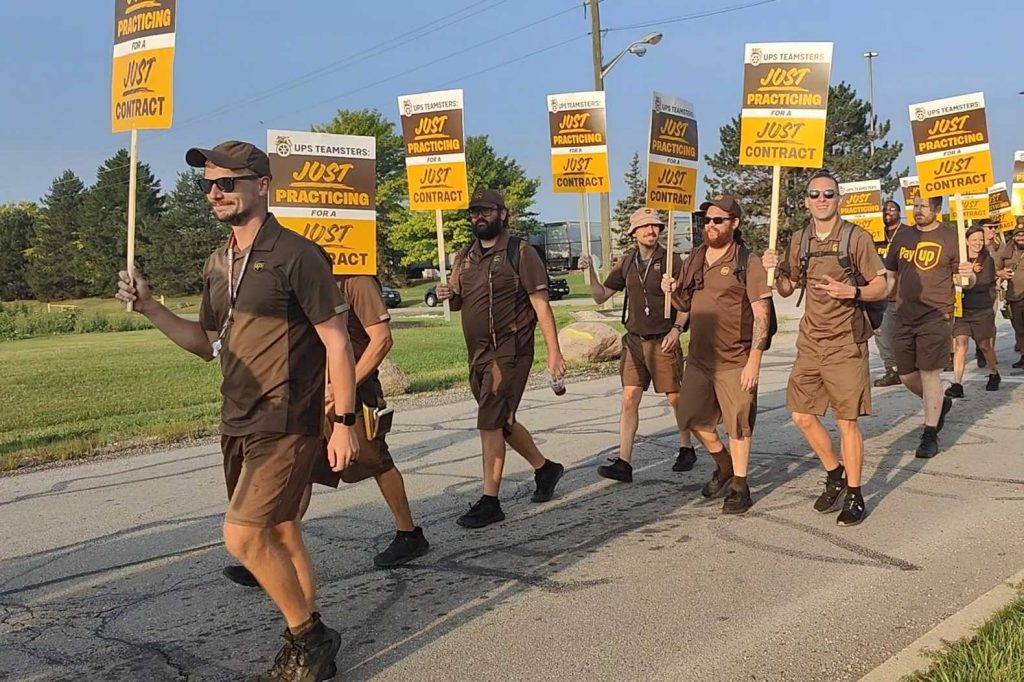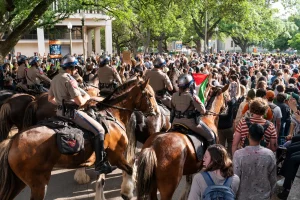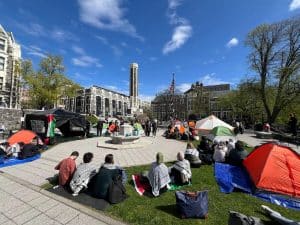This Tuesday, UPS and Teamsters announced they have reached a tentative agreement for a new contract for UPS workers nationwide, a week before over 340,000 workers were set to go on strike across the country in what would be the biggest strike of its kind in U.S. history. Now that strike is on hold as workers read, debate, and vote on the tentative agreement.
After years of stagnant wages and deplorable working conditions, UPS workers have been organizing around the clock to fight for their demands, including much higher starting salaries for part-time workers and ending the two-tier system. Many of these demands reflect conditions that are not just limited to UPS; winning them would have implications for the struggles of other workers in this sector who face similar conditions of precarity, low wages, hazardous conditions, and weak contracts (if they have contracts at all).
Just the possibility of a strike at UPS has struck fear in the hearts of capitalists and politicians, who stand to lose billions in profits from just one day of workers walking off the job; but it has also galvanized and inspired thousands of workers and activists who see that if the working class fights back with the sharpest tool at our disposal — the strike — we can win even the demands the bosses say are impossible.
Left Voice sat down with UPS part-time worker Luigi Morris to discuss his impressions of the contract, what’s next for this struggle and why he is going to vote No.
With the announcement of a tentative agreement for UPS workers, many people — from Teamsters leaders to politicians — are heralding this as a “historic” and “game-changing” contract. Given what we know so far, what are the big changes reflected in the latest contract? What does this mean for the 340,000 workers nationwide who were preparing to go on strike on August 1?
After UPS walked away from the bargaining table, stalling negotiations for two weeks, UPS and the Teamsters bargaining team reached a tentative agreement on Tuesday morning. This means that we will not go on strike next week as we review the proposed contract and vote on it.
We know that our determination to strike and our collective action within the last months — with practice pickets, meetings, and demonstrations — scared UPS to its core and have already forced it to make several big concessions. After decades of major losses that lowered labor standards for UPS workers and the logistics sector, this is a contract that makes some gains.
We also know that we have the support of the working class as a whole, as well as strong public support for our fight. People understand that UPS workers, along with Amazon workers and many others, were at the frontline in the Pandemic, risking our lives while the bosses made billions; we can’t continue with the conditions we’ve been under for years and now we’re fighting for more.
What are some of the important victories or steps forward in this contract?
On the positive side, the hated two-tier system of drivers will come to an end. This system, imposed on UPS workers by the last contract, created a system where there was no equal pay for equal work among drivers. At the same time, there are still limits to how drivers’ work is organized; many drivers were expecting that the four year progression to the top pay rate in Tier 1 be reduced to just two years, but there is no stipulation for that as of now.
Another win is that there won’t be forced overtime on a worker’s scheduled day off.
A/C will be installed in all package trucks bought after January 1, 2024 and fans will be installed in the trucks’ cargo compartments. This is not a small thing, especially as workers have been fighting for this demand for many years and the company said it was “impossible.” However, it only makes for the minimum amount of package cars fitted with A/C to be 28,000 (~1/4 of the current fleet) during the life of the agreement. But we need to get these changes as soon as possible. We can’t continue exposing and risking drivers and helpers to these conditions. We face record temperatures across the world this summer due to climate change and stories of workers dying on the job from the heat are becoming disturbingly more common. Remember that UPS driver Esteban Chavez Jr. died last year after collapsing in his truck from heat stroke.
The proposed contract certainly makes some significant changes to wages, wages that have been degraded with years of inflation. When they released the highlights of the TA, it was worded in such a way as to make full- and part-time workers think that we were going to get a $10.25 raise through the life of the contract; but now that we’ve seen the actual language of the proposed contract, it’s clear that we will get $7.50 over the next five years — that includes the automatic bump of $2.75 in 2023. That is still well below inflation. Further, it is still not clear what changes are being made to pensions across classifications and the different supplementals across the country.
UPS was forced to make other important concessions. The latest TA stipulates that Martin Luther King Jr. Day will be a paid holiday, that we’ll get two extra sick days, we’ll get more Surepost on package cars, and more.
At the same time, there are many important shortcomings to this contract, especially those concerning part-timers.
Part-time workers at UPS are some of the most historically exploited sectors of the workforce; they are fighting for big changes in their workplace. One of the main demands coming from sectors of the rank and file is a $25/hour starting wage. Does the proposed contract meet those expectations?
For part-timers this was a historic opportunity to fight for $25/h minimum as starting wage. We were called essential during the pandemic and we generated record profits for UPS. UPS CEO Carol Tomé made $27 million last year. Meanwhile, part-time workers at UPS are living out of their cars, working two or more jobs, and hardly seeing their families. They are making poverty wages amid rising inflation. We deserve more. We are still national news and there is momentum to fight for more.
Going from $15.50 to $21 an hour as a starting wage is an important jump, but as part timers we were already very behind on our wages after decades of sellouts. $21 isn’t even the bare minimum of what our wages should be if we adjust for inflation.
Part-time workers with seniority are especially frustrated. For them, under the TA, someone who has been working for 9 years and is already making $17.85 will only get bumped to $21.50. That is not much more than the new starting wage, and it’s still way below what they should be making given how inflation ensures that our wages don’t go as far and the cost of living keeps going up.
We heard a lot about the need to get rid of the two-tier system among drivers. It is an amazing win that it has come to an end with this proposed contract. But this TA maintains the informal “two-tier system” between part-time workers and drivers. A top-rate driver will make $49/h by the end of the contract while new part-timers will start with $21 and after three years will reach $23; they will make less than half the wage of a full-time driver. Under the proposed contract, inside workers would still have second-class status and it would create a new tier separating workers hired before and after August of this year.
There are still big changes that have to be made to our working conditions. Based on the highlights from the TA, it does seem that we are going to get A/C in the warehouses. In the midst of this massive heat wave, part-time workers like me work in sweltering warehouses, packing boxes that weigh up to 70 or even 100 pounds. It’s unsafe. It’s inhumane. And we don’t get paid enough to go home and rest afterwards — many people work two, three, or more jobs just to get by.
With the proposed TA, we will still only be guaranteed 3.5 hours of work per day, which does not translate to even a subsistence wage. We will still only get a ten minute break, which is far from enough to rest from the back-breaking pace of inside work, to get out of the heat for a bit, and also have time to go for food, drink and use the bathroom.
There was no hazard pay during the Pandemic. Despite exposing ourselves, risking our families’ and communities’ lives, keeping society running and bringing people essential goods, and generating record profits for the company, the TA doesn’t even include an “essential workers” bonus.
Many of the demands of part-time workers have not yet been met; we should not be left behind with this contract.
Many politicians and media outlets are celebrating a possible strike being averted with this tentative agreement, claiming that the struggle is over. But in the end, only the workers decide whether the contract is ratified. What’s next for the contract fight? How do workers decide whether this is the contract they want or if they are going to keep fighting for more?
The full contract was just released. There will be meetings to discuss it and the voting will start on August 3 and last until August 22. If it is voted down, the negotiations will have to resume and the possibility of strike will be on the table again.
So far workers’ opinions span the entire spectrum: some workers are satisfied with the TA, while others have mixed feelings and are not totally decided yet; an important sector is unhappy with it and is planning to push for a no vote. But there is a general feeling that we could have fought for more. We were ready to strike.
The upcoming meetings, conversations at work, exchanges on social media, and the time we take to read the full TA will allow us to have a better characterization of where workers stand. We definitely need not only time, but democratic spaces to discuss every aspect of the contract — the gains, the limits, and what we want to fight for. We need to organize spaces where we don’t only passively listen to reports about the TA, but where we openly share our different opinions and plan next steps.
Within our ranks, one of the weaknesses we have to overcome is the lack of organization among part timers. It is very important that warehouse workers create democratic avenues to reflect on the proposed contract, debate it, and make our own decisions about the way ahead. It’s the only way we can know for sure that the contract works for us. Of course, this is challenging because we all have exhausting shifts and most of us have two or three jobs. Many workers are also mothers and have the double work of raising their kids and earning enough money to pay the bills. Our bodies are usually broken. Sometimes we have parking lot meetings, which are a good space for discussion and debate, but we need to find other creative ways to discuss as a collective and to strengthen the unity between drivers and part timers that is so vital to unite our struggle in the power of a single fist.
UPS workers have been gearing up for this fight for years, and all eyes have been on them for months as negotiations stalled and a strike date loomed closer. Why was just the threat of a strike enough to get UPS to make significant concessions in this tentative agreement? What does this mean for UPS workers who are ready to fight for better conditions?
First I think that there was no need to rush to reach a TA just a few hours after resuming the negotiations. There were still six days before the strike was set to begin. We could have definitely taken what was good and continued to use the threat of the strike to pressure UPS toward even greater concessions. And if they didn’t meet those demands, we were ready to strike. UPS was working against the clock, not us.
The threat of the strike was powerful because of the strategic role that UPS workers play in the U.S. economy. Withholding our labor would have not only caused billions of dollars in losses for UPS, but it would have also disrupted the entire economy. This would have put the government in a tough spot, caught between wanting to ensure that capitalist profits flow and Joe Biden’s posturing as a friend of the organized labor movement to win back a working class social base to the Democratic Party ahead of the elections. We had all the leverage in our favor to have a historic strike; we would have joined the over one hundred and sixty thousand workers who are already on strike and who were already sending us their solidarity. There could have been over half a million workers on strike! That’s what the working class needs to fight back. Our strike would have even involved UPS pilots, who swore not to cross the picket line by flying UPS packages.
UPS was eager to avert a strike that could cost the bosses billions of dollars and set the bar higher for the next contract negotiations. The politicians are happy that they may not have to deal with working class unrest. That’s why we won the concessions that are already in the tentative agreement; that’s the power of our collective action and it’s a power we can’t give up now. Our most powerful weapon is the strike. It’s also the reason why workers should consider voting no on the current agreement — If we actually use that weapon, we could win all of our demands, including getting part timers a starting wage of $25/h.











